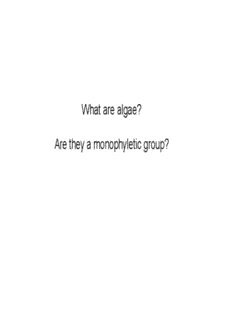
What are algae? Are they a monophyletic group? - Amherst College PDF
Preview What are algae? Are they a monophyletic group? - Amherst College
What are algae? Are they a monophyletic group? How did chloroplasts arise? 1. Cyanobacteria: photosynthetic bacteria 2. Endosymbiosis: engulfing of cyanobacterium by early eukaryotic cell (primary endosymbiosis) 3. Primary endosymbiosis: red and green algae 4. Secondary endosymbiosis: engulfing eukaryotic cell that contains photosynthetic plastid; capturing a red or green alga 5. Brown algae such as kelp got their chloroplasts via secondary endosymbiosis Primary endosymbiosis Cyanobacterium Green & Red algae Secondary endosymbiosis Brown algae Primary endosymbiosis Green algae Secondary endosymbiosis Consumption/use of cyanobacteria • Spirulina (Arthrospira sp.) • Occurs naturally in tropical/subtropical lakes • Food source for Aztecs: cultivation of bacterial mats • Chad—dried cakes called Dihé • High amount of protein, essential fatty acids, vitamins & minerals • Suggestion of medicinal/health benefits including anti-HIV • Source of blue dye for new (2008) naturally-dyed Smarties in UK • Used as animal feed additive Artificial dye Spirulina clip Spirulina dye 100 species of marine algae consumed, especially in Asia • Domestication of macroalgae recent compared to terrestrial plants • <20 species domesticated in last 200 years, seven within last 10 years • Important to understand and control reproduction and propagation • Seaweed aquaculture in Asia, Chile for food and colloid production • High protein content, vitamins and minerals • Main farmed species: brown kelps Laminaria sp. (Kombu) and Undaria pinnatifida (Wakame); red algae Porphyra sp. (Nori) and Gracilaria sp. Brown algae Laminaria sp. (Kombu) • Used for centuries in Japan, with majority cultivated in Hokkaido (cultivated since 1730) • Often boiled with aniline dye malachite green • Main ingredient for soup stock dashi, also source of glutamic acid (umami taste); brewed with tea (kombucha)
Description: